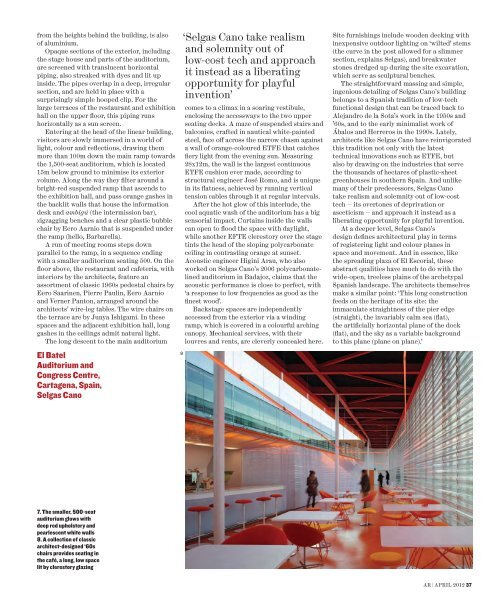El Batel Auditorium and Congress Centre, Cartagena, Spain, Selgas ...
El Batel Auditorium and Congress Centre, Cartagena, Spain, Selgas ...
El Batel Auditorium and Congress Centre, Cartagena, Spain, Selgas ...
- No tags were found...
You also want an ePaper? Increase the reach of your titles
YUMPU automatically turns print PDFs into web optimized ePapers that Google loves.
from the heights behind the building, is alsoof aluminium.Opaque sections of the exterior, includingthe stage house <strong>and</strong> parts of the auditorium,are screened with translucent horizontalpiping, also streaked with dyes <strong>and</strong> lit upinside. The pipes overlap in a deep, irregularsection, <strong>and</strong> are held in place with asurprisingly simple hooped clip. For thelarge terraces of the restaurant <strong>and</strong> exhibitionhall on the upper floor, this piping runshorizontally as a sun screen.Entering at the head of the linear building,visitors are slowly immersed in a world oflight, colour <strong>and</strong> reflections, drawing themmore than 100m down the main ramp towardsthe 1,500-seat auditorium, which is located15m below ground to minimise its exteriorvolume. along the way they filter around abright-red suspended ramp that ascends tothe exhibition hall, <strong>and</strong> pass orange gashes inthe backlit walls that house the informationdesk <strong>and</strong> ambigú (the intermission bar),zigzagging benches <strong>and</strong> a clear plastic bubblechair by Eero aarnio that is suspended underthe ramp (hello, Barbarella).a run of meeting rooms steps downparallel to the ramp, in a sequence endingwith a smaller auditorium seating 500. On thefloor above, the restaurant <strong>and</strong> cafeteria, withinteriors by the architects, feature anassortment of classic 1960s pedestal chairs byEero Saarinen, pierre paulin, Eero aarnio<strong>and</strong> Verner panton, arranged around thearchitects’ wire-leg tables. The wire chairs onthe terrace are by Junya ishigami. in thesespaces <strong>and</strong> the adjacent exhibition hall, longgashes in the ceilings admit natural light.The long descent to the main auditorium<strong>El</strong> <strong>Batel</strong><strong>Auditorium</strong> <strong>and</strong><strong>Congress</strong> <strong>Centre</strong>,<strong>Cartagena</strong>, <strong>Spain</strong>,<strong>Selgas</strong> Cano8‘<strong>Selgas</strong> Cano take realism<strong>and</strong> solemnity out oflow-cost tech <strong>and</strong> approachit instead as a liberatingopportunity for playfulinvention’comes to a climax in a soaring vestibule,enclosing the accessways to the two upperseating decks. a maze of suspended stairs <strong>and</strong>balconies, crafted in nautical white-paintedsteel, face off across the narrow chasm againsta wall of orange-coloured ETFE that catchesfiery light from the evening sun. Measuring28x12m, the wall is the largest continuousETFE cushion ever made, according tostructural engineer José romo, <strong>and</strong> is uniquein its flatness, achieved by running verticaltension cables through it at regular intervals.after the hot glow of this interlude, thecool aquatic wash of the auditorium has a bigsensorial impact. Curtains inside the wallscan open to flood the space with daylight,while another EFTE clerestory over the stagetints the head of the sloping polycarbonateceiling in contrasting orange at sunset.acoustic engineer Higini arau, who alsoworked on <strong>Selgas</strong> Cano’s 2006 polycarbonatelinedauditorium in Badajoz, claims that theacoustic performance is close to perfect, with‘a response to low frequencies as good as thefinest wood’.Backstage spaces are independentlyaccessed from the exterior via a windingramp, which is covered in a colourful archingcanopy. Mechanical services, with theirlouvres <strong>and</strong> vents, are cleverly concealed here.Site furnishings include wooden decking withinexpensive outdoor lighting on ‘wilted’ stems(the curve in the post allowed for a slimmersection, explains <strong>Selgas</strong>), <strong>and</strong> breakwaterstones dredged up during the site excavation,which serve as sculptural benches.The straightforward massing <strong>and</strong> simple,ingenious detailing of <strong>Selgas</strong> Cano’s buildingbelongs to a Spanish tradition of low-techfunctional design that can be traced back toalej<strong>and</strong>ro de la Sota’s work in the 1950s <strong>and</strong>’60s, <strong>and</strong> to the early minimalist work ofÁbalos <strong>and</strong> Herreros in the 1990s. lately,architects like <strong>Selgas</strong> Cano have reinvigoratedthis tradition not only with the latesttechnical innovations such as ETFE, butalso by drawing on the industries that servethe thous<strong>and</strong>s of hectares of plastic-sheetgreenhouses in southern <strong>Spain</strong>. <strong>and</strong> unlikemany of their predecessors, <strong>Selgas</strong> Canotake realism <strong>and</strong> solemnity out of low-costtech − its overtones of deprivation orasceticism − <strong>and</strong> approach it instead as aliberating opportunity for playful invention.at a deeper level, <strong>Selgas</strong> Cano’sdesign defines architectural play in termsof registering light <strong>and</strong> colour planes inspace <strong>and</strong> movement. <strong>and</strong> in essence, likethe spreading plaza of <strong>El</strong> Escorial, theseabstract qualities have much to do with thewide-open, treeless plains of the archetypalSpanish l<strong>and</strong>scape. The architects themselvesmake a similar point: ‘This long constructionfeeds on the heritage of its site: theimmaculate straightness of the pier edge(straight), the invariably calm sea (flat),the artificially horizontal plane of the dock(flat), <strong>and</strong> the sky as a variable backgroundto this plane (plane on plane).’7. The smaller, 500-seatauditorium glows withdeep red upholstery <strong>and</strong>pearlescent white walls8. A collection of classicarchitect-designed ‘60schairs provides seating inthe café, a long, low spacelit by clerestory glazingar | april 2012 37
















